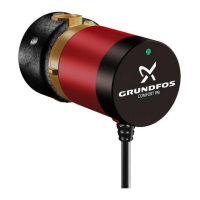4.1.3 Dry installation
Install pumps in dry installation permanently in a
pump room.
The pump motor is enclosed and watertight.
For vertical, dry installations, type D, install
the pump on a permanent concrete foun-
dation.
For horizontal, dry installations, type H, the
pump is mounted on a base stand.
1. Mark and drill mounting holes in the concrete
foundation.
2. Fit the base plate or base stand on the concrete
with anchor bolts. Check the pull-out strengths
required for bolts below.
3. Check that the base plate is horizontal or base
stand is vertical.
4. Fasten the pump to the base plate or base stand.
Fit isolating valves on either side of the pump.
5. Fit the inlet and outlet pipes and isolating valves, if
used. Make sure the pump is not stressed by the
pipes.
6. Adjust the length of the motor cables by coiling
them up on a relief fitting to ensure that the cables
are not damaged during operation. Make sure to
have enough cable length for service. Fasten the
relief fitting to a suitable hook. Make sure that the
cables are not sharply bent or pinched.
7. Connect the motor cables and the control cable, if
any.
In horizontal installations, use a reducer
between the inlet pipe and the pump. The
reducer must be eccentric and has to be
installed the way its straight edge is point-
ing upwards. Therefore the accumulation
of air in the inlet pipe and the risk of opera-
tion disturbance are eliminated.
Make sure that the pipes are installed with-
out the use of undue force. Do not allow
the pump to carry loads from the weight of
the pipes. Use loose flanges to ease the
installation and to avoid pipe tension at
flanges and bolts.
Do not use elastic elements or bellows in
the pipes.
The inlet and outlet pipes are bolted to the pump by
flange connections.
Foundation
To ensure minimum vibration levels, all parts of the
system must be sufficiently stiff and firmly anchored:
• The foundation and concrete must be strong
enough to support the weight of the pump
including accessories, the liquid passing through
the pump and the forces generated by the pump.
• As a rule of thumb, the mass of the concrete
foundation must be minimum three to five times
the mass of the supported equipment and must
have sufficient rigidity to withstand the axial,
transverse and torsional loads generated by the
pumps in operation.
• For pumps up to 350 kW, the foundation must be
15 cm wider than the base plate and 25 cm wider
in case of larger pumps.
• The concrete used in the foundation must have a
minimum tensile strength of 250 N/cm
2
.
• Always use epoxy grout to fasten the pump base
plate to the foundation.
Pull-out strengths for anchor bolts
Installation type H
Range Bolts
Pull-out strength
[kN]
50-62 4 x M16 10
66-70 6 x M24 25
Installation type D
Dry installation Bolts
Pull-out strength
[kN]
DN 100 3 x M20 18
DN 150
6 x M20
18
DN 200 18
DN 250
6 x M24
25
DN 300 25
DN 500/400 * 25
DN 500 25
* Base plate inlet DN 500 and pump inlet DN 400.
The pull-out strengths stated are without
safety factor. The required safety factor
may depend on the materials and the
methods used for anchoring.
20
English (GB)

